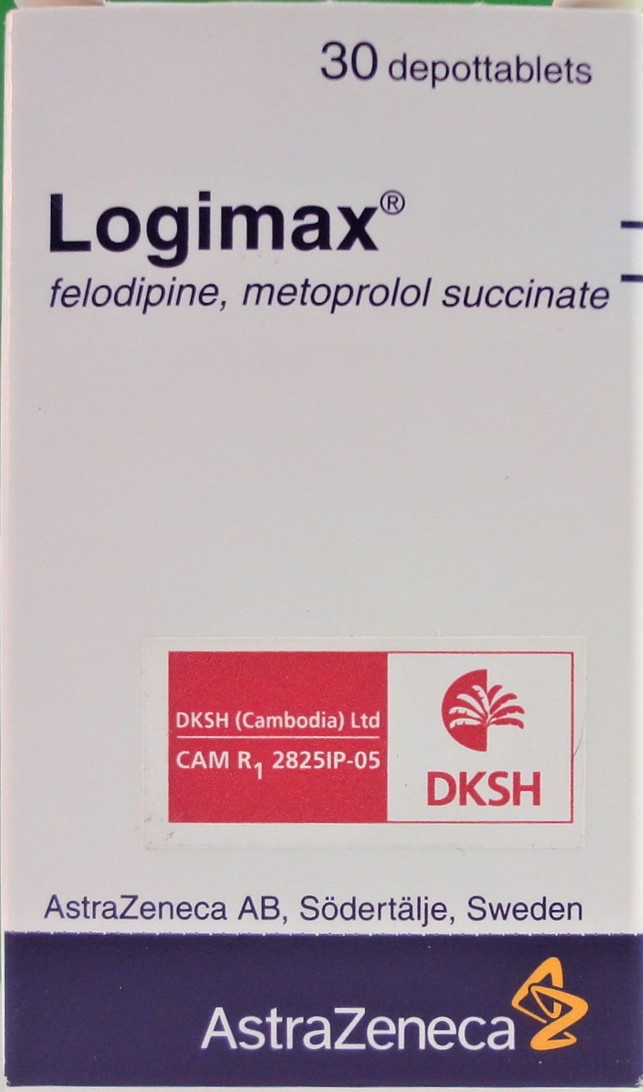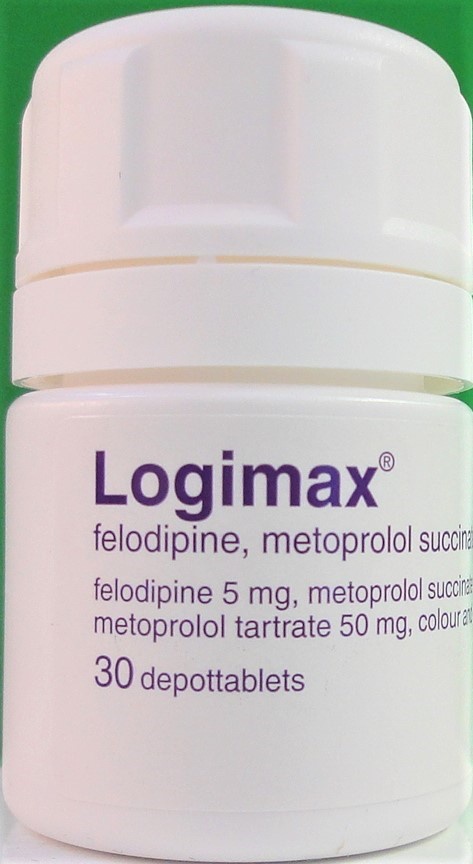LOGIMAX Tablet
ក្រុមហ៊ុនផលិតឱសថ:
Astra Zeneca AB, Sweden
ក្រុមហ៊ុនចែកចាយឱសថនៅប្រទេសកម្ពុជា:
DKSH


- សារធាតុសកម្ម
- ប្រសិទ្ធិភាពព្យាបាល និង កម្រិតប្រើប្រាស់
- ហាមប្រើ
- ផលរំខាន
- អន្តរប្រតិកម្ម
- ស្ត្រីមានផ្ទៃពោះ និង ស្ត្រីបំបៅដោះកូន
- ការប្រុងប្រយ័ត្នជាពិសេស
- សកម្មភាពឱសថ បរិយាយប័ណ្ណឱសថ
-
សារធាតុសកម្ម
Felodipine 5mg, Metoprolol tartrate 50mg
-
ប្រសិទ្ធិភាពព្យាបាល និង កម្រិតប្រើប្រាស់
គុណភាពព្យាបាល
- ឱសថនេះប្រើសំរាប់ព្យាបាលជម្ងឺសម្ពាធឈាមឡើង ពិសេស ក្នុងករណីការព្យាបាលដោយឱសថប្រឆាំងសម្ពាធឈាមឡើងក្រុម Beta-blocker ឬក្រុម Calcium antagonists នៃប្រភេទ Dihydropyridine តែមួយមុខ ហើយគ្មានប្រសិទ្ធភាព។
កំរិតនិងរបៀបប្រើ
- លេបជាមួយទឹកឬទឹកដោះគោ នៅពេលព្រឹក 1ថ្ងៃ1ដង ឬ 1ថ្ងៃ2ដង ក្នុងករណីចាំបាច់ (មិនត្រូវកាច់ ឬទំពារ ឬបៀមទេ)។
- ចំពោះអ្នកជម្ងឺថ្លើមខ្សោយខ្លាំង ឬតម្រងនោមខ្សោយខ្លាំង មិនត្រូវប្រើលើសពី1គ្រាប់ក្នុង1ថ្ងៃទេ។Hypertension.
The dosage is individual. The normal dosage is one Logimax prolonged release tablet (5+50 mg) per day. If required, the dose may be increased to twice daily.
The prolonged release tablet is given once daily, in the morning. The prolonged release tablet must be swallowed with water, and must not be divided, crushed or chewed. The prolonged release tablet may be taken on an empty stomach or together with a light meal with a low fat and carbohydrate content.
-
ហាមប្រើ
ហាមប្រើចំពោះ
- អ្នកធ្លាប់មានប្រតិកម្មជាមួយសារធាតុផ្សំណាមួយនៃឱសថនេះ ឬក្រុម Beta-blocker ឬក្រុម Calcium antagonist ឬ Dihydropyridine
- ស្ត្រីមានផ្ទៃពោះ អ្នកមានជម្ងឺបេះដូងធ្ងន់ធ្ងរ ដូចជា : Angina pectoris, Degree II and III AV block, Bradycardia or Hypotension Symptomactic, Acute myocardial infarction etc.Known hypersensitivity to any of the components of the product or to other dihydropyridines or p-blockers. Pregnancy. Acute myocardial infarction. Unstable angina pectoris. Degree II and III AV block. Patients with unstable uncompensated heart failure (pulmonary oedema, hypoperfusion or hypotension), and patients with continuous or intermittent inotropic therapy with p-receptor agonism. Symptomatic bradycardia or hypotension. Sick sinus syndrome. Cardiogenic shock. Severe peripheral vascular disease with threat of gangrene. Logimax must not be given to patients with suspected acute myocardial infarction with a heart rate of <45 beats/minute, P Q interval >0.24 seconds or systolic blood pressure <100 mmHg.
-
ផលរំខាន
Common(>1/100)
swelling of the ankles, headache, dizziness, fatigue,facial redness,nausea,fatigue, peripheral cold in extremities, bradycardia, palpitations,abdominal pain, nausea, vomiting, diarrhoea, constipation
Less common (>1/1000, <1/100)
exanthema,pruritus,paraesthesia,
chest pain, weight gain,transient worsening of heart failure,breathlessness, bronchospasm in patients with bronchial asthma or asthmatic disorders, sleep disturbances
Rare(>1/10,000, <1/1000)
urticaria,arthralgia, myalgia,syncope secondary to hypotension,impotence/sexual dysfunction,hyperhidrosis, hair loss, altered taste, reversible disturbance of libido,thrombocytopenia,prolonged AC conduction time, cardiac arrhythmias, oedema, syncope,hypersensitivity reactions affecting the skin, aggravated psoriasis, photosensitivity,elevated transaminases,nightmares, depression, memory disturbances, confusion, nervousness, agitation, hallucinations,visual disturbances, dry and/or irritated eyes,tinnitus
Very rare (<1/10,000)
fever,extrasystoles, hypotension with tachycardia, which in susceptible subjects can cause aggravated angina pectoris, leucocytoclastic vasculitis,hyperglycaemia,gingival hyperplasia, gingivitis,photosensitivity, angioedema in the form of swollen lips or tongue,hypersensitivity reactions,elevation of liver enzymes,urinary frequency
-
អន្តរប្រតិកម្ម
The following combinations with Logimax should be avoided:
Barbituric acid derivatives: Barbiturates (studied for pentobarbital) induce the metabolism of metoprolol to a slight degree through enzyme induction.
Propafenone: When propafenone was started in four patients who were already receiving treatment with metoprolol, the plasma concentrations of metoprolol increased 2-5-fold, and two patients experienced typical metoprolol side effects. The interaction was confirmed in tests on eight healthy trial subjects. The interaction is probably due to the fact that propafenone, like quinidine. inhibits the metabolism of metoprolol via cytochrome P4502D6. The combination is thought to be difficult to manage since propafenone also has p-receptor-blocking properties.
Verapamil: In combination with p-receptor blockers (has been described for atenolol, propranolol and pindolol), verapamil can cause bradycardia and a fall in blood pressure. Verapamil and p-blockers have additive inhibitory effects on AV conduction and sinus node function.
The following combinations with Logimax may require a dose adjustment:
Class I antiarrhythmic drugs: Class I antiarrhythmic drugs and (3-receptor blockers have additive negative inotropic effects, which can result in serious haemodynamic side effects in patients with impaired left ventricular function. The combination should also be avoided in “sick sinus syndrome” and pathological AV conduction. The interaction is best documented for disopyramide.
Diphenhydramine: Diphenhydramine reduces (2.5-fold) clearance of metoprolol to alpha-hydroxymetoprolol in rapid hydroxylators via CYP2 D6. At the same time, the effects of metoprolol are potentiated.
Clonidine: The hypertensive reaction in the event of sudden withdrawal of clonidine can be potentiated by p-blockers. If concomitant treatment with clonidine must be discontinued, the (3-blocker must be withdrawn a few days before clonidine.
Diltiazem: Diltiazem and p-receptor blockers have additive inhibitory effects on AV conduction and sinus node function. Pronounced bradycardia has been observed (case reports) in cases of combination treatment with diltiazem.
Non-steroidal anti-inflammatory drugs (NSAIDs): Anti-inflammatory drugs of the NSAID type counteract the antihypertensive effect of p-receptor blockers. Indomethacin in particular has been studied. This interaction is thought not to occur with sulindac. In a study with diclofenac no such reaction could be detected.
Phenylpropanolamine: Phenylpropanolamine (norephedrine) in single doses of 50 mg can increase diastolic blood pressure to pathological values in healthy trial subjects. Propranolol generally counteracts the rise in blood pressure induced by phenylpropanolamine. However, P-receptor blockers can cause paradoxical hypertensive reactions in patients who take high doses of phenylpropanolamine. Hypertensive crises during treatment with phenylpropanol-amine alone have been described in a few cases.
Epinephrine: There have been about ten reports of marked hypertension and bradycardia in patients on treatment with non-selective p-receptor blockers (incl. pindolol and propranolol) who were given epinephrine (adrenaline). These clinical observations have been confirmed in studies on healthy trial subjects. It has also been suggested that epinephrine as an additive to local anaesthetics can cause these reactions on intravascular administration. The risk is thought to be considerably less with cardio-selective p-receptor blockers.
Quinidine: Quinidine inhibits the metabolism of metoprolol in so-called rapid hydroxylators (approx. 90 % in Sweden), resulting in greatly increased plasma levels and increased (3-blockade. Corresponding interactions are thought to occur with other p-biockers that are metabolised by the same enzyme (cytochrome P4502D6).
Amiodarone: One case report suggests that patients treated with amiodarone may develop pronounced sinus bradycardia if they are treated concomitantly with metoprolol. Amiodarone has an extremely long half-life (approx. 50 days), which means that interactions can occur a long time after the preparation has been withdrawn.
Rifampicin: Rifampicin can induce the metabolism of metoprolol, resulting in reduced plasma levels.
Digitalis glycosides: In association with p-blockers, may increase atrioventricular conduction time and may induce bradycardia.
Patients receiving concomitant treatment with metoprolol and other p-receptor blockers (e.g. eye drops) or MAO inhibitors should be kept under careful supervision. Inhalation anaesthetics potentiate the cardiodepressive effect in patients who are being treated with p-receptor blockers. The dose of oral antidiabetic drugs may need to be adjusted for patients receiving p-blockers.
-
ស្ត្រីមានផ្ទៃពោះ និង ស្ត្រីបំបៅដោះកូន
Pregnancy
Logimax must not be given during pregnancy.
There is a lack of adequate data on treatment of pregnant women with felodipine. Felodipine must not be used during pregnancy, as foetal damage was seen in animal studies (see Preclinical safety data). Calcium antagonists can inhibit premature contractions in the uterus, but definite confirmation of labour being prolonged in the case of a full-term pregnancy is lacking. A risk of foetal hypoxia may occur in the event of hypotension in the mother and reduced perfusion of the uterus on account of redistribution of the blood supply as a result of peripheral vasodilatation.
Metoprolol should be given during pregnancy and lactation only if it is absolutely necessary, p-receptor blockers can cause bradycardia in the foetus and new-born, and in the breast-fed infant. During the last trimester and in connection with parturition, therefore, the above should be borne in mind when prescribing this preparation.
Lactation
Felodipine and metoprolol pass into breast milk. If the nursing mother takes therapeutic doses of felodipine, only a very small dose is transmitted to the infant via the breast milk. There is insufficient experience of felodipine treatment during lactation to permit an assessment of the risks for the infant. Felodipine is therefore not recommended during lactation. In cases in which the medical benefit of continued treatment is considered to predominate, the alternative of discontinuing breast-feeding should be considered.
-
ការប្រុងប្រយ័ត្នជាពិសេស
ការប្រុងប្រយ័ត្ន
- ត្រូវប្រុងប្រយ័ត្នក្នុងការប្រើឱសថនេះជាមួយ Digitalis ព្រោះអាចបណ្ដាលអោយមាន AV Block។
- មិនត្រូវប្រើឱសថ Verapamil ចាក់តាមសរសៃទេ នៅពេលអ្នកជម្ងឺប្រើឱសថ Logimax នេះ។
- ត្រូវប្រុងប្រយ័ត្នប្រើឱសថនេះ ចំពោះអ្នកមានជម្ងឺហឺត (Bronchial Asthma) ឬស្ទះទងសួត បើចាំបាច់គួរប្រើរួមគ្នាជាមួយឱសថពង្រីកទងសួត (Bronchodilatators)។
- មិនត្រូវបញ្ឈប់ការប្រើឱសថនេះ (Logimax) ភ្លាមៗនោះទេ បើចង់ឈប់ប្រើឱសថនេះ ត្រូវបន្ថយកំរិតប្រើបន្តិចម្ដងៗក្នុងរយៈពេល1-2សប្ដាហ៍សិន។
- ណែនាំអោយមានអ្នកជម្ងឺបន្តការប្រើឱសថ Logimax មិនអាចបញ្ឈប់បានទេ
- ជាការល្អ មុនប្រើឱសថនេះត្រូវពិគ្រោះជាមួយគ្រូពេទ្យព្យាបាល។Combination treatment with digitalis. Logimax can exacerbate the symptoms of peripheral vascular disease, e.g. intermittent claudication. Severely impaired renal function (GFR<30ml/min),. Aortic stenosis. Impaired hepatic function. Heart failure following acute myocardial infarction. Hypotension, which in susceptible subjects can cause myocardial ischaemia. Severe acute pathological conditions with metabolic acidosis.
Logimax must not be used for first treatment of previously untreated patients.
Logimax should not be given to patients with latent or manifest cardiac insufficiency without concomitant treatment of this condition.
Treatment with Logimax may affect carbohydrate metabolism or mask hypoglycaemia, but the risk is less than with non-selective beta-receptor blockers.
In isolated cases an existing moderate disturbance of AV-conduction time may be exacerbated (possibly leading to AV block).
Intravenous administration of verapamil must not be given to patients being treated with Logimax.
In patients with Prinzmetal’s angina the number and severity of angina attacks may increase, due to alpha-receptor-mediated constriction of coronary vessels. Non-selective beta-blockers therefore must not be used for these patients. Beta1-selective receptor blockers must be used with care.
In cases of bronchial asthma or other chronic obstructive pulmonary diseases adequate bronchodilator therapy must be given concomitantly. The dose of beta2-stimulants may need to be increased.
Treatment with beta-blockers may make the treatment of an anaphylactic reaction more difficult. Adrenaline treatment in normal doses does not always produce the expected therapeutic effect.
If Logimax is given to patients with phaechromocytoma, treatment with alpha-blockers should be considered. Concomitant administration of drugs that induce CYP3A4 leads to greatly reduced levels of felodipine. This combination should be avoided.
Abrupt discontinuation of beta-blockade, especially in high-risk patients, can be risky and can exacerbate chronic heart failure and increase the risk of myocardial infarction and sudden death. If possible, any discontinuation of Logimax should therefore take place gradually over a period of 1-2 weeks.
Prior to surgery, the anaesthetist must be informed that the patient is on Logimax. It is recommended that beta-blocker treatment is not withdrawn in patients who are undergoing surgery.
-
សកម្មភាពឱសថ
which is a calcium antagonist with a selective effect on pre-capillary resistance vessels, and metoprolol. which is a p,-selective receptor blocker. As a result of the mechanisms of action of the two substances complementing each other (felodipine reduces peripheral vascular resistance and metoprolol reduces cardiac output), a more pronounced antihypertensive effect is obtained than with either of the two drugs in monotherapy. With Logimax an even and effective lowering of blood pressure over the entire interval between doses (24 hours) is achieved.
*ព័ត៌មានឱសថត្រូវបានរៀបរៀងដោយ អ៊ីម៉ាតុគឹ មេឌីក (ខេមបូឌា) ដោយផ្អែកលើប្រភពព័ត៌មានខាងក្រោម។ សម្រាប់ព័ត៌មានលម្អិត សូមស្វែងរកនៅក្នុងក្រដាសព័ត៌មាននៃឱសថនីមួយៗ ឬ សាកសួរទៅកាន់ក្រុមហ៊ុនឱសថឬតំណាងចែកចាយនៃឱសថនីមួយៗ។
ប្រភពព័ត៌មាន៖
- ក្រដាសព័ត៌មាននៃឱសថសម្រាប់អ្នកជំនាញវេជ្ជសាស្ត្រដែលប្រើប្រាស់នៅប្រទេសជប៉ុន (Pharmaceutical and Medical Devices Agency, Pmda): https://www.pmda.go.jp
- ព័ត៌មានសង្ខេបនៃឱសថសម្រាប់អ្នកជំងឺដែលប្រើប្រាស់នៅប្រទេសជប៉ុន: http://www.rad-ar.or.jp
